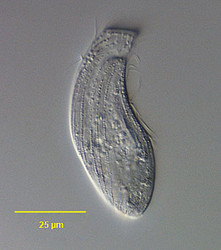Stephanopogon apogon
Naoji Yubuki and Brian S. LeanderIntroduction
Stephanopogon apogon is one of two species in the genus that has been studied at both the ultrastructural and molecular phylogenetic levels. This was the first species to be described with the aid of transmission electron microscopy, and these studies demonstrated that Stephanopogon was not a member of the Ciliata (Lipscomb and Corliss 1982; Patterson and Brugerolle 1988). A culture of S. agpogon containing the euglenozoan Rhynchomonas nasuta as a food source is available at the American Type Culture Collection ATCC (50096).
The molecular phylogenetic position of this species was addressed using both actin and small subunit ribosomal RNA gene sequences; this study showed that S. apogon is closely related to the heterolobosean Percolomonas cosmopolitus (Yoon et al 2008).
Characteristics
Stephanopogon apogon has a slit-like apical cytostome, but lacks the prominent apical barbs present in other species in the genus.
- Absence of anterior barbs, truncate anterior end
- Rounded posterior end
- Cell about 50-90 µm long
- 6 longitudinal rows of flagella (cilia) on the ventral surface
References
Lipscomb, D. l. and Corliss, J. O. 1982. Stephanopogon, a phylogenetically important "ciliate," shown by ultrastructural studies to be a flagellate. Science 215:303-304.
Patterson, D. J. and Brugerolle, G. 1988. The ultrastructural identity of Stephanopogon apogon and the relatedness of the genus to other kinds of protists. Europ Europ. J. Protistol. 23:279-290.
Yoon, H. S., Grant, J., Tekle, Y. I., Wu, M., Chaon, B. C., Cole, J. C., Logsdon Jr. J. M., Patterson, D. J., Bhattacharya, D. and Katz, L. A. 2008. Broadly sampled multigene trees of eukaryotes. BMC Evol. Biol. 8:14.
Title Illustrations

| Scientific Name | Stephanopogon apogon |
|---|---|
| Location | Collected from a commercial saltwater aquarium in Boise, Idaho, USA |
| Specimen Condition | micrograph |
| Source | Stephanopogon apogon |
| Source Collection | Micro*scope |
| Image Use |
 This media file is licensed under the Creative Commons Attribution-NonCommercial-ShareAlike License - Version 2.5. This media file is licensed under the Creative Commons Attribution-NonCommercial-ShareAlike License - Version 2.5.
|
| Copyright |
© 2004

|
| Scientific Name | Stephanopogon apogon |
|---|---|
| Acknowledgements | Image used under license to MBL (micro*scope) -- David Patterson. |
| Specimen Condition | micrograph |
| Image Use |
 This media file is licensed under the Creative Commons Attribution-NonCommercial License - Version 3.0. This media file is licensed under the Creative Commons Attribution-NonCommercial License - Version 3.0.
|
| Copyright | © 2001 D. J. Patterson, L. Amaral-Zettler and V. Edgcomb |
| Scientific Name | Stephanopogon apogon |
|---|---|
| Location | Collected from a commercial saltwater aquarium in Boise, Idaho, USA |
| Comments | Portrait of the colorless benthic marine protist, Stephanopogon apogon (Borror, 1965)attempting (ambitiously) to ingest a large diatom. |
| Specimen Condition | micrograph |
| Source | Stephanopogon apogon |
| Source Collection | Micro*scope |
| Image Use |
 This media file is licensed under the Creative Commons Attribution-NonCommercial-ShareAlike License - Version 2.5. This media file is licensed under the Creative Commons Attribution-NonCommercial-ShareAlike License - Version 2.5.
|
| Copyright |
© 2004

|
About This Page
This page is being developed as part of the Tree of Life Web Project Protist Diversity Workshop, co-sponsored by the Canadian Institute for Advanced Research (CIFAR) program in Integrated Microbial Biodiversity and the Tula Foundation.

The University of British Columbia, Vancouver, Canada
Brian S. Leander

The University of British Columbia, Vancouver, British Columbia, Canada
Correspondence regarding this page should be directed to Naoji Yubuki at and Brian S. Leander at
Page copyright © 2008 and Brian S. Leander
All Rights Reserved.
- First online 23 September 2008
- Content changed 23 September 2008
Citing this page:
Yubuki, Naoji and Brian S. Leander. 2008. Stephanopogon apogon. Version 23 September 2008 (under construction). http://tolweb.org/Stephanopogon_apogon/129958/2008.09.23 in The Tree of Life Web Project, http://tolweb.org/












 Go to quick links
Go to quick search
Go to navigation for this section of the ToL site
Go to detailed links for the ToL site
Go to quick links
Go to quick search
Go to navigation for this section of the ToL site
Go to detailed links for the ToL site